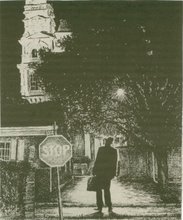Robert
Gibbons, Animated Landscape, BlazeVox
[Books], 2016, 146 pp, $16.
Peter Anastas
(This review appeared in Dispatches on 12/1/16)
Speaking
recently at the Gloucester Writers Center, poet and Olson scholar Don Byrd
advised poets who are inspired by Charles Olson not to attempt to follow him
because Olson was uniquely unfollowable.
Rather, Byrd said, they should attempt to move beyond Olson with their
own work, as the poet himself had done with respect to his masters, Pound and
Williams.
Among
poets who have learned from Olson while forging their own unique path, Robert
Gibbons stands out. Though widely
published and admired among poets, scholars of poetry, critics, and curators of
contemporary art, Robert Gibbons has been less known to discerning readers of new
American poetry. This is about to change
with the publication by BlazeVox of Animated
Landscape, Gibbon’s major new collection of poems. Those who care about the life of poetry in a
time when there are many MFAs in verse but fewer poets who appeal directly to
the human condition should attend to what Richard Deming calls Gibbons’
“universal and inclusive vision.”
Gibbons’
poetry is informed not only by the crucial texts he’s read and internalized—Kristeva,
Davenport, Olson himself— but also by the music and visual art that has animated
his life and work—the jazz of Coltrane, the inventions of Bach, the paintings
of Clyfford Still (about whom he has written incisively in Olson/Still: Crossroad)—along with the walks he has taken daily in
the places he’s lived—Gloucester, Salem, Washington, DC, Boston, Portland,
ME, and now Denver—bringing them to life and into his pages through
conversations with those he has encountered going about their daily business,
as Gibbons has gone about his as both secret sharer and astute observer. His is a poetry that is as intensely lived as
it is informed by a poised intelligence; a poetry of the heart and mind, where
intellect and feeling do not conflict but, instead, fuse into incandescence, as
Gibbons writes: “where senses reach an/intoxicated height, where air alone
is/magic, silence music, touch between/us dispelling all dread.”
In his
comments on the book’s jacket Richard Deming observes equally that Gibbons
“carries Olson’s excavations into the present tense…in his own measure of
music, personal and specific, yet universal and inclusive.” Thus Gibbons has lent important credence to
Don Byrd’s advice to move beyond Olson, while, at the same time, paying homage
to his teacher, as Olson did to his:
No, not surprising to
find
Olson equating the cave
with our own
internal “maze,” our
bodies with geography.
say kidneys as sea, or
spine as mountain range,
brain as Arctic, coccyx Antarctic,
heart solar system,
lung valley of breath,
preferring stone, wood clay to iron,
brick, steel, glass,
copper, or plastic, those basics to any manmade
transformation, &
feeling inside himself there in the cave, or geography,
creatures that came
before us,
horses rearing up.
(This review appeared in Dispatches on 12/1/16)



No comments:
Post a Comment